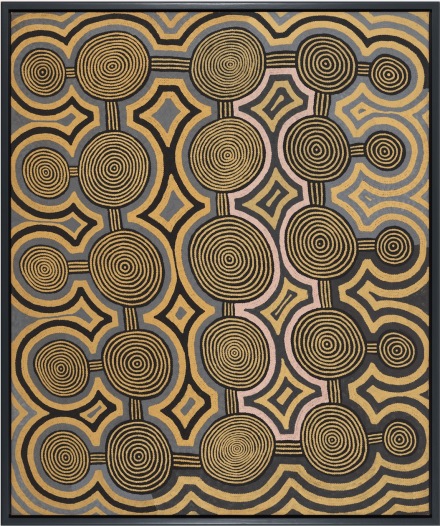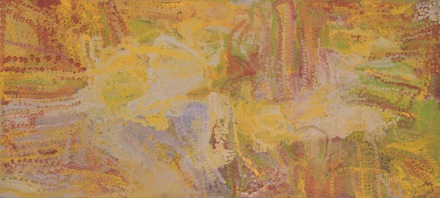
Ronnie Tjampitjinpa, Tarkulnga (1988) Ronnie Tjampitjinpa , © Copyright Agency. Licensed by Artists Rights Society (ARS), New York, 2019 Photo: Rob McKeever, Courtesy Gagosian
Following up on the much-praised New York exhibition documenting the leading painters from the Central and Western Desert regions of Australia, Gagosian’s Los Angeles exhibition space has pulled together a second iteration of Desert Painters of Australia, a strikingly powerful show documenting the indigenous art traditions of the country.
In the late 1960s, the Australian government moved several communities from the Western Desert region—primarily Pintupi, Luritja, Warlpiri, and Arrernte peoples—to the Papunya settlement, about 150 miles south of Alice Springs in the Northern Territory, a forced displacement that simultaneously centered the Indigenous Australian art community around a centralized hub where artists would gather to create murals works on canvas, and other forms drawing on ceremonial decorations and sand art. The result was a transposition of historically-resonant modes to the physical media of contemporary art and which has since presented a new outlet and opportunity for Papunya Tula artists to reexamine the imagery and present their culture to outsiders through transcendental visual codes.

Desert Painters of Australia Part II, Installation View, 2019 Artworks © Artists and Estates, Photo: Fredrik Nilsen, Courtesy Gagosian
Many of the works in this exhibition, made during the last twenty years, reveal the ways in which generations of Indigenous Australian artists have responded to their progenitors, new traditions and old mixing together to create a new discourse modeled on shared challenges and expressive techniques. The common dotting techniques used throughout, for example is exemplified in an untitled painting from 2001 by Willy Tjungurrayi (1932–2018), one of the few remaining artists of the first generation of these artists, while George Tjungurrayi’s compositions draw a similar pattern-oriented mode towards tight concentric lines and mesmerizing.

Desert Painters of Australia Part II, Installation View, 2019 Artworks © Artists and Estates, Photo: Fredrik Nilsen, Courtesy Gagosian
The show also explores women’s participation in art, mixing together crafts like batik and bone jewelry in with the paintings and sculptures to create nuanced depictions of the lives of its subjects. Emily Kame Kngwarreyem for instance, focused on women’s activities, from batik making to the harvesting of seasonal crops. These detailed depictions make for a fluid exchange between historical modes and modern art practice, a conversation that bounds the work up in an ongoing conversation around the nature of artistic practice, origination and iteration.

Emily Kame Kngwarreye, Merne Akngerre (1992), © Emily Kame Kngwarreye: Copyright Agency. Licensed By Artists Rights Society (Ars), New York, 2019 Photo: Rob Mckeever Courtesy Gagosian
Tracing a vivid conversation between divergent styles and historical modes, the exhibition is a landmark entry in the presentation and representation of these cultures to the world outside Australia, and is a can’t miss event.
The show closes September 6th.
Read more:
Desert Painters of Australia Part II [Gagosian]



